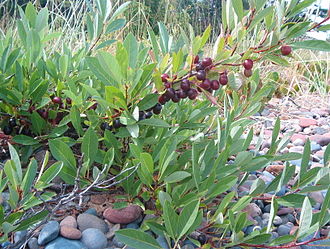
Native to shorelines and dunes in northern US from Maine to Montana, south to Virginia and Colorado, this deciduous shrub is a member of the rose family, Rosaceae, that also includes almonds, hawthorn, and lady’s mantle. It grows 2-6′ tall and has a rhizomatous root system and spreading, low, ascending or prostrate branches. The twigs are red to reddish brown and develop a waxy cuticle. The lanceolate leaves are leathery, l.6-2.8″ long, and have finely serrated margins. In spring before the leaves appear, umbel-like clusters of 2-4 white flowers with 5 white egg-shaped petals appear in the leaf axils and give way to 1/2″ wide reddish black drupes that ripen to almost black in summer. The plants withstand wind but not maritime conditions. They provide cover and food for wildlife including birds and mammals and are also valued for their role in stabilizing sand dunes. The genus name, Prunus, comes from the Greek word προύνη meaning plum, a prominent member of this genus. The specific epithet, pumila, is the Latin word meaning dwarf.
Type: Deciduous shrub
Outstanding Feature: Soil stabilization
Form: Low, spreading, prostrate or ascending
Growth Rate: Rapid
Bloom: Umbel-like clusters of 2-4 white petaled flowers in spring
Size: 2-6′
Light: Full sun
Soil: Sandy, medium moist to dry, well-drained; drought tolerant once established
Hardiness: Zones 3-7
Care: Low maintenance
Pests and Diseases: Powdery mildew, silverleaf, honey fungus, leaf mining moths, vine weevil, cherry black fly
Propagation: Seed with 2-3 months of cold stratification (slow to germinate), cuttings of half-ripe wood with a heel in July/August, layering in spring
Outstanding Selections: ‘Catskill’
Photo Credit: Wikipedia